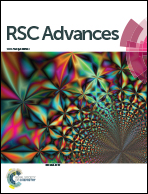Rapid synthesis of MgO nanoparticles & their utilization for formulation of a propylene glycol based nanofluid with superior transport properties
Abstract
Experiments were performed on the synthesis of magnesium oxide nanoparticles (30–40 nm), followed by their dispersion in propylene glycol to prepare stable MgO–propylene glycol nanofluids through extensive probe ultrasonication for 25 h. The influence of MgO nanoparticle concentration (0–2 vol%) and temperature on viscosity and thermal conductivity of MgO–propylene glycol nanofluids was investigated. While the relative viscosity of the nanofluid decreased with nanoparticle concentration to a temperature of 30 °C, the relative viscosity–nanoparticle concentration exhibited a minimum at 1 vol% in the temperature range of 35–60 °C. The enhancement in thermal conductivity of nanofluids increased linearly with nanoparticle concentration and was found to be independent of temperature, with an average enhancement of ∼20% for 2 vol% MgO–propylene glycol nanofluid. Our results show that the thermal conductivity enhancement in MgO–propylene glycol can be attributed to both interfacial layering and Brownian motion.


 Please wait while we load your content...
Please wait while we load your content...